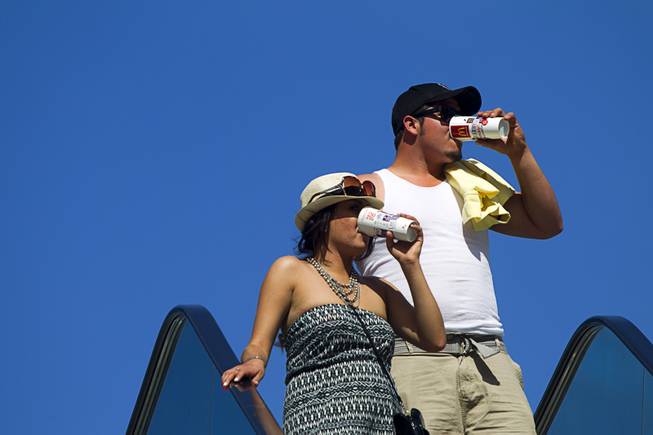
A couple keeps hydrated while visiting the Las Vegas Strip Sunday, June 9, 2013. Sunday’s high temperature was 109, two degrees shy of the record.
Sunday, Aug. 5, 2018 | 2 a.m.
Whether you’ve lived here for 10 years or are just passing through, you know Las Vegas gets hot—triple-digit-degrees-for-weeks hot. If you’re new here, you might not know how important it is to stay hydrated during summer and how easy it is to become dehydrated under the scorching desert sun. Samantha Coogan, director of the didactic program in nutrition and dietetics at UNLV, shares the best ways to stay cool, hydrated and healthy.
What causes dehydration?
Most people think dehydration is caused by a lack of water, and while that’s certainly one component, it is also a depletion of electrolytes. “When you really see health problems occur is when you’re depleted of things like sodium, potassium, magnesium—different things that are running through the bloodstream and affect energy levels and metabolism,” Coogan said.
Electrolytes are key
Sodium, potassium, chloride, phosphate and magnesium are a few of the body’s essential electrolytes. These minerals aid motor, digestive and neurological functions, and when depleted or overconsumed, throw our bodies into a state of imbalance. Symptoms of electrolyte depletion can include irregular heartbeat, fast heart rate, fatigue, nausea and more. Hypernatremia, or loss of sodium in the blood, is most common in high-endurance athletes, Coogan said, and can include similar symptoms.
Wet heat vs. dry heat
Think of a humid climate as a steam room (wet heat) and an arid climate as a sauna (dry heat). “While a sauna may reach higher temperatures than a steam room, you will produce more sweat in a steam room due to the moisture in the area,” Coogan said. So it’s important to hydrate in both climates. And when it’s humid and hot during Las Vegas’ monsoon seasons, hydration is even more crucial.
Are you dehydrated?
“If you feel like you need to take down a bottle of water, you’re probably already at the point of dehydration,” Coogan said. Prevention is key. Consistently monitor urine color throughout the day to help become more familiar with your hydration levels. “It will be darker in the morning, which is normal,” Coogan said, “but if you’re approaching that dark apple cider color, it’s getting into a dangerous level of dehydration.”
Eat your water
Consuming fresh fruits and vegetables throughout the day can help replenish water and electrolytes naturally. Some of the best-hydrating foods include cantaloupe, celery, cucumbers, green bell peppers, iceberg lettuce, peaches, radishes, star fruit, strawberries, tomatoes, watermelon.
How much water do you need?
It’s important to consume fluids as often as possible throughout the day, Coogan said, but even in the desert, you can drink too much water. “We love water, but it’s all about maintaining balance.” If you’re drinking plenty of water but still feel thirsty, Coogan said you may be “drowning your body” by depleting electrolyte levels. Consider swapping an 8-ounce glass of water for an electrolyte-enhanced beverage such as Gatorade, Powerade or coconut water to replenish electrolyte levels and achieve a state of euhydration—the technical term for optimal hydration. Coogan does not recommend drinking a gallon of water in one sitting. Instead, try to evenly distribute water intake throughout the day to bring levels back to normal.
Heat stroke
Watch for symptoms of heat stroke or heat exhaustion, which include loss of motor function; confusion; hands that are sweaty, clammy or completely dry; muscle aches and cramps; dizziness; hot/flushed skin; nausea or vomiting; and convulsions.
How much water do you need a day?
There are many different opinions about daily water consumption. According to the Mayo Clinic, the recommendation is 3.7 liters (124 ounces) for men and 2.7 liters (92 ounces) for women. Your body size, climate, level of activity and overall health can also affect how much water you need.
Get to know your sweat
“If you’re a person who sweats more than normal or you have a lot of salt coming out in your sweat, you’re going to have to pay closer attention and make sure you have a beverage on you at all times,” Coogan said. “If it looks like there’s a whitish color on [someone’s] skin, you can see they are putting out more sodium.” Coogan recommends adding salt to your water before a workout (especially hot yoga), or drinking Pedialyte, which will help balance electrolyte levels during the workout. It’s also important to avoid diuretic beverages such as coffee and tea, which “could bring you to a state of dehydration quicker” by potentially increasing your urine and sweat output. If you exercise heavily, Coogan recommends weighing yourself before and after your workout, and drinking a cup of water for every pound lost during your exercise session.
This story originally appeared in the Las Vegas Weekly.
